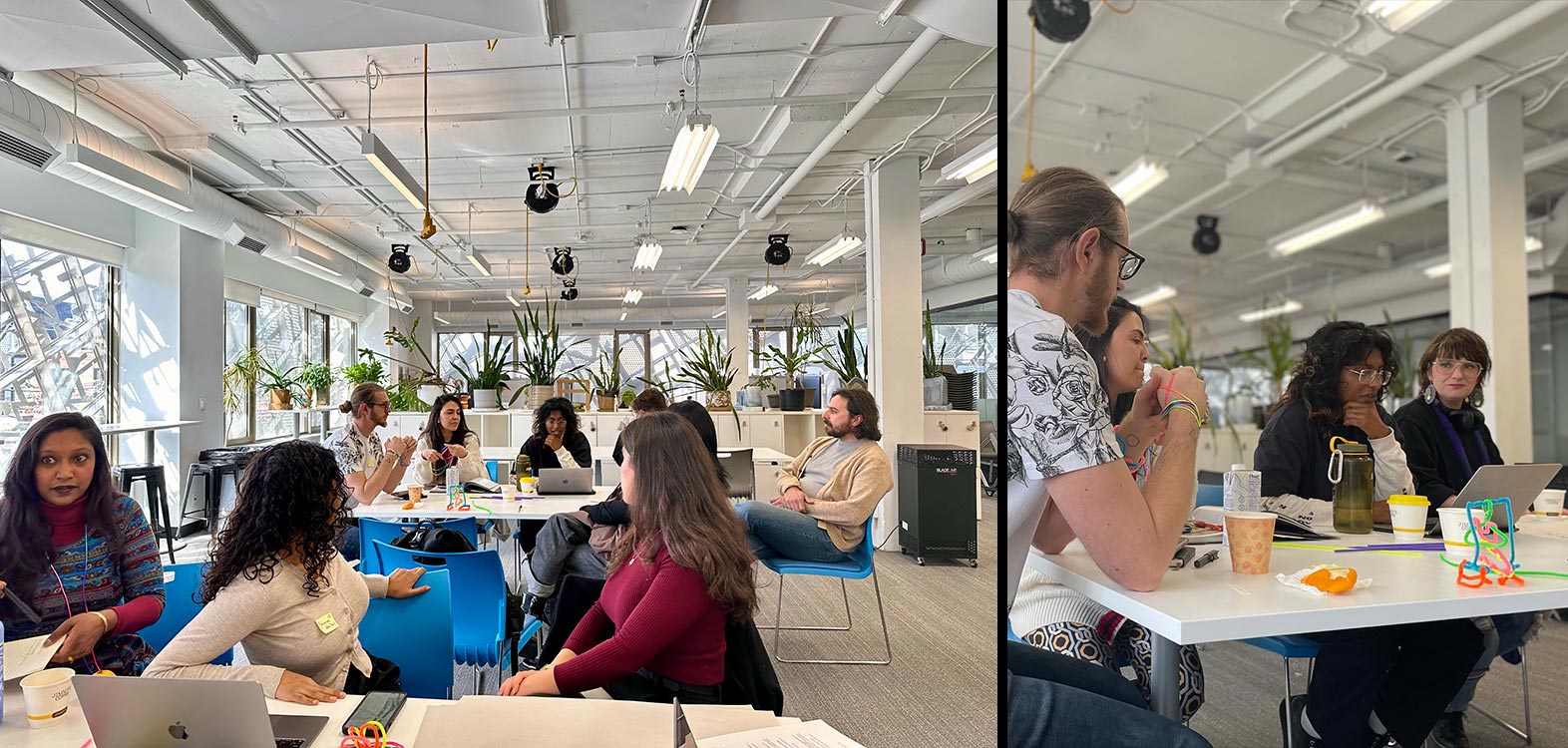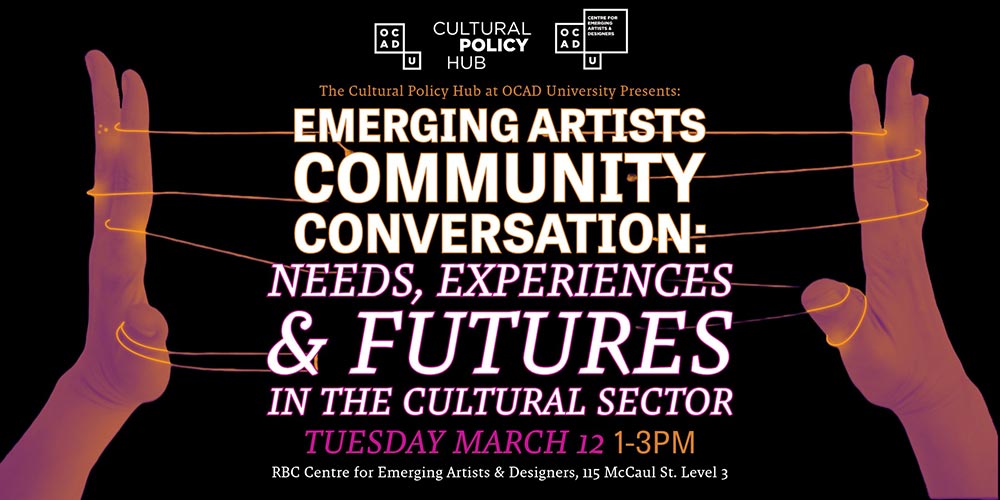A Community Conversation with Emerging Artists: Needs, Experiences & Futures in the Cultural Sector

TLDR: On March 12, 2024, the Cultural Policy Hub at OCAD University hosted a community conversation with emerging artists from a variety of creative and cultural backgrounds to share lived experiences and needs and envision a flourishing future for the arts and cultural sector. This conversation was intended to augment a series of consultations that the City of Toronto has been hosting on its ten-year Action Plan for Toronto’s Culture Sector. The session hosted by the Hub was geared toward emerging artists, designers, and cultural workers to ensure they have a say in the planning for our city’s cultural ecosystem. This post summarizes the key things we heard, which we shared with the City of Toronto for them to consider during the next phase of the planning process.

Who We Spoke To
The 21 emerging artists, designers and cultural workers that participated in the session hold many intersecting identities and affiliations to queer, trans, newcomer, racialized and ethno-cultural communities. They live in neighbourhoods across the city, from Roncesvalles/Parkdale to Scarborough and beyond. Many noted engagements in other activities outside their artistic and cultural practices, including activism, community health and wellbeing, urban planning and sports and fitness.
The participants engage in a variety of cultural practices, including:
- singing, dancing;
- ceramics and sculpture;
- painting and drawing;
- writing;
- film and photography;
- performance, acting, theatre, stage management;
- multidisciplinary visual arts;
- illustration, graphic design;
- makeup artistry;
- and cultural work and arts collaboration more broadly.
Most participants hold multiple part-time or freelance positions, while the rest work full-time as cultural workers and pursue their artistic practices off the side of their desks. To give just one example of the participants’ intersecting identities and practices, one attendee is a 29-year-old multidisciplinary visual artist specializing in illustration, ceramics, painting and drawing, who self-identifies as Queer, BIPOC and South Asian. This participant makes a living by teaching classes at an art institution, organizing workshops in their studio, and selling their visual artwork as a creative entrepreneur.
What We Heard
Participants were invited to organize into groups and engage in facilitated dialogue that focused on three key questions. Some key highlights and responses from those discussions are summarized below.
How do you experience culture in Toronto today?
Contributors shared a wide array of activities, both communal and individual, through which they engage in culture. The simple act of meeting with artists and engaging with their work was most commonly cited. Many, including students, felt that they connected with culture and gained experience through teaching/learning, mentorship, and opportunities to collaborate with others. Festivities and parties (raves, DJ parties, block parties, street festivals, etc.) were the spaces where people felt most connected with their communities through culture. Food, informal gatherings, and sports also provided opportunities for connection. Some participants also noted that the home space has become an important place for cultural engagement. One contributor’s comment, paraphrased here, summed up what they ultimately felt was important when thinking through the spaces in which they engage with art and culture: “It doesn’t really matter what space it is, but more so where the artists and my people are.”
What do you need to better experience culture in Toronto?
Part of the conversation focused on barriers to participation in culture. Contributing emerging artists and cultural workers discussed what they need to overcome these barriers or what needs to be done at a policy level to remove them. The key issue cited was the lack of affordable housing and creative space. Responding to this issue, contributors identified the need to: safeguard welcoming and affordable space in which to live and work (i.e. studios, artist-run spaces, community centers, informal spaces, etc.); explore innovate space creation methods to secure these spaces; and support programming and convening practices led by and for emerging artists within these spaces.
Many of the participants also noted the inadequacies of the existing granting system to support them as emerging practitioners. Some participants pointed out that the reliance on an unpredictable grant system has put them into positions of financial insecurity. They noted that the grant system does not offer artists a means to make an adequate, long-term and sustainable living. Additionally, the competitive nature of the system pits them against established artists who are often more likely to receive funding. Stagnancy and cuts to those granting systems and bodies amid increased demand have exacerbated the pressures felt by the respondents. Notably, one contributor mentioned that receiving a grant “felt like winning the lottery.” In addition, the evaluation and reporting criteria for some grants drew critiques, as artists claimed that the requirements are overly complicated and the need to satisfy those criteria can at times stifle creativity.
Contributors cited labour precarity as a key challenge they face working in the sector. Many shared their experiences of trying to make ends meet while gaining experience in no- to low-wage entry-level positions in a sector that is plagued by low wages. The groups generally expressed that these endemic low wages were in part the result of a perceived lack of public appreciation of the value that artists and cultural workers bring to the city. Their impression was that other cities and states (especially in Europe) held artists and cultural workers in much higher esteem, which contributed to more tenable living and working conditions.
In 10 years, what should Toronto's cultural sector and scene be like?
Finally, contributing emerging artists and cultural workers were invited to consider what Toronto’s cultural sector might look like in a decade. Overall, respondents had two modest ambitions for the future:
- To live in a city where they could simply have enough resources to afford to live and have their basic needs met,
- To have people recognize and appreciate the value that they as artists bring to the city.
- To see underrepresented artists, organizations and their associated initiatives supported and engaged in decision-making within their communities.
Some participants cited the importance of community, and hoped for a future where community-driven cultural activities reduced the need for government and corporate presence and influence in the arts.

What Should Be Done?
The Cultural Policy Hub encouraged artists and cultural workers, such as those who convened for this session, to get engaged in policy discussions. Participants were guided in exploratory discussions about some of the policy tools that could be developed, piloted, expanded or refined through the city’s culture plan to help address systemic barriers that impact the arts and cultural sectors.
What are your top solutions/ideas for how the city can support culture in Toronto?
Contributors shared several ideas to address the precarity they face as emerging creatives living in a city with limited resources and employment opportunities. Supports to housing, increases to grant funding and more research or action to pilot basic income guarantee programs were just some of the solutions cited.
Their ideas have been compiled below across four categories: 1) Space and Affordability, 2) Funding and Resources, 3) Labour Precarity & Value of Creative Work, and 4) Equity, Access and Cultural Redress in the Cultural Sector.
Space and Affordability
- Space Support & Protection
- Implement additional rent control measures.
- Develop policies to protect community-identified spaces of cultural significance.
- Deliver municipal funding/grants for existing cultural spaces.
- Expand the Creative Co-Location Facilities Property Tax Subclass Designation.
- Expand community benefits for cultural spaces and co-located living-community spaces.
- Innovative Space Creation
- Explore new space-sharing models for art & creation spaces.
- Support new co-op housing & community land trust policy tools based on successes in other cities (Vancouver, BC; Oakland, CA).
- Develop municipal funding/grants for new cultural spaces.
- Explore arts-specific inclusionary zoning.
- Convening & Programming
- Offer funding geared specifically toward community-care initiatives and accessibility.
- Develop new policy supports that protect and encourage programming and convening based on local (PlazaPOPs public spaces) and non-local (London, England indoor and outdoor spaces) successes.
- Reduce regulatory barriers in policy to create better access to public spaces for programming and events.
- Support emerging artist-led programs and events for network-building opportunities
Funding & Resources
- Economic Support
- Support the introduction of a federal basic income guarantee based on the success of CERB and other programs for consistent financial support.
- Provide tax incentives to enhance artists’ fiscal stability.
- Funding Allocation
- Expand grant programs and prevent budget reductions.
- Reallocate funding to support emerging artists.
- Finance works that offer alternative and critical narratives to institutional structures.
- Program Structure
- Develop grant applications that prioritize innovative visions over rigid metrics.
- Establish a matching system for collaboration between artists and institutions based on successes in other jurisdictions (e.g. Business Arts South Africa).
- Provide basic financial support mechanisms so artists can independently finance their projects, ensuring creative autonomy.
Labour Precarity & Value of Creative Work
- Recognition & Valuation
- Better recognize artists and cultural workers for their contributions.
- Work to change public perception of artists as professionals.
- Increase the perceived value of the arts to attract diverse funding sources.
- Socio-Cultural Impact
- Refocus the cultural plan to prioritize metrics like diversity, inclusion and health supports over economic impact.
- Engage in values-based discussions and campaigns to elevate the arts' societal value.
- Address various forms of labour precarity in the arts sector.
- Investment & Partnership
- Consider the arts as an essential service to justify investment.
- Develop partnerships between the private sector, philanthropy and other industries to acknowledge artists' roles in problem-solving.
- Implement a strategy that quantifies the arts' impact on society.
- Explore how artists can bridge political polarization and contribute to social cohesion.
Equity, Access & Cultural Redress in the Cultural Sector
- Strategic Focus
- Develop an arts & equity strategy with a focus on emerging artists, especially from underrepresented groups.
- Prioritize equity, access, cultural recognition, reconciliation and Indigenous self-determination in planning.
- Socio-Cultural Impact
- Support local artists in their organizing efforts around human rights and other social issues.
- Integrate systemic changes for cultural equity (e.g., defunding the police, abolishing capitalism, ending apartheid, electing new officials, shifting political power)
- Introduce a city-led mentorship program to facilitate knowledge and skill sharing, mentorship opportunities & network connections among emerging and established artists who are traditionally underrepresented in the sector.
By holding space for meaningful conversation, emerging artists and cultural workers can play a role in informing policy thinking and nurturing a supportive cultural ecosystem. The Hub looks forward to maintaining dialogue with emerging artists and staying engaged at all levels of policymaking. Thank you to all our participants who contributed, as well as our facilitators and notetakers Miru Yogarajah, Philip Leonard Ocampo, Yasmine Izmeth and Samuel La France!

